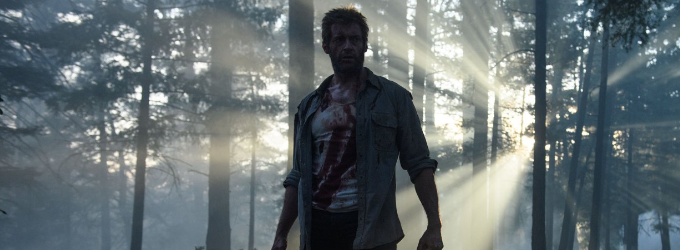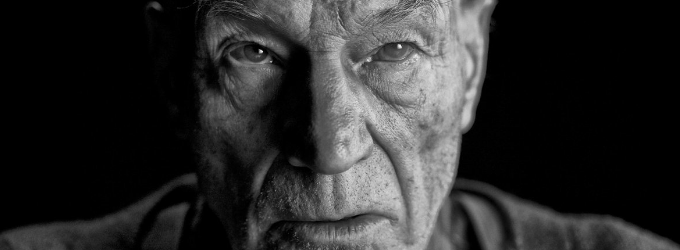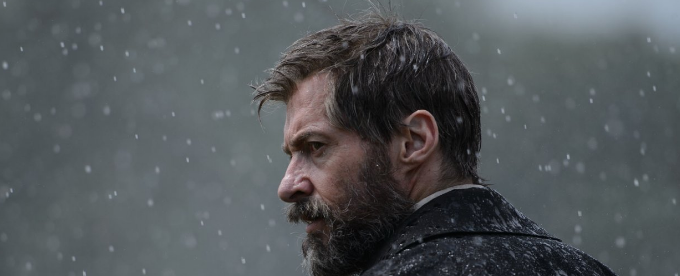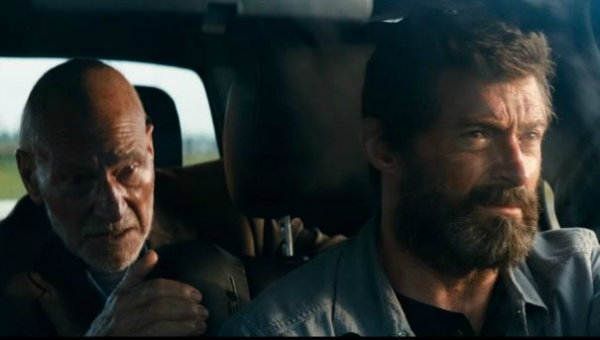Movies based on comic books have been in the ascendancy for some time, especially those sharing ‘universes’. However, there is some argument that those standing on their own two feet (or at least being less reverential to such expanding behemoths) are given greater scope to craft a good story with meaningful character arcs. Those commentators just acquired a powerful weapon in that debate with LOGAN.
Set in 2029, with no new mutants born in over 25 years, LOGAN finds Hugh Jackman‘s Wolverine drifting around Texas as a limo driver, hopping across the Mexican border to care for an aged and dementia-ridden Professor Charles Xavier (Patrick Stewart) with the assistance of Caliban (Stephen Merchant). He is sought out by a nurse – Gabriela (Elizabeth Rodriguez) – formerly employed at Alkali Labs, a company known to have experimented with mutation in various abhorrent ways on children. She entrusts Logan with delivering young Laura (Dafne Keen) to ‘Eden’ on the North Dakota-Canada border. Supposedly a safe haven for the few remaining mutants, Logan is forced to flee he and Xavier’s slow slide into irrelevance on what he feels is a forlorn quest.
LOGAN is almost an entirely character-driven affair (if underscored by a fair bit of brutality, right from the opening scene). Where it separates itself from its X-brethren is that it gives us some further insight into Jackman’s character for the first time in arguably 15 or so years. He has become the burnout threatened and hinted at in more than one of the franchise’s films, and the other characters seem to have to work harder than ever to have him act as the classic good guy.
He’s seemingly borderline alcoholic, his body heals slower and he’s more misanthropic than ever – slaughtering a band of thieves for trying to spring his hubcap. Here, however, we linger on the attitude he displays and the personal consequences of his actions for longer than has been typical of other films featuring the character. Mangold lingers on his injuries. When asked if the claws hurt, way back in 2000, Logan’s response is “Every time”. Here, the camera shows, the script doesn’t tell. This time, no one – in either the audience or the script – needs to ask.

When asked [in X-MEN] if the claws hurt, Logan’s response is “Every time”. Here, the camera shows, the script doesn’t tell. This time, no one – in either the audience or the script – needs to ask.
Patrick Stewart’s Professor X is a heartbreaking portrait of age and dementia – a person defined by their great mind, now losing it. Few superhero films have had the courage to frame their characters in such a way: the decline of age, illness or self-destruction wrought upon them. Those that do quickly have their heroes bounce back in some fashion (THE DARK KNIGHT RISES being a prime recent example, HANCOCK one that never fulfilled the premise’s intrigue). Although Stewart’s Xavier cuts loose with the swears a bit, the supposed power of his abilities hinders our main characters as they malfunction and decay. Suffering from seizures, he can stop everyone dead in their tracks and cause pain, but has no ability to control it – so much so that the government has supposedly declared him a weapon of mass destruction: an incident in which seven mutants died is alluded to throughout. So often the saviour, and not without gentle reminders of that when rounding up some startled horses, there will be no climactic triumphant moment for him.
Xavier is at once a powerful reminder of the bygone peak of these heroes, and a saddening display of their future crumbling to dust. The dynamic between these two drives the start of the film – Logan clearly sensing a responsibility for his old mentor and seeing Xavier’s decline mirroring his own. Far from the master/sage mentor relationship trope typical to origin stories, this at least is novel for the recent genre history (the original X-MEN, BATMAN BEGINS, DOCTOR STRANGE, ANT-MAN, MAN OF STEEL, maybe even the upcoming SPIDER-MAN: HOMECOMING, the list truly is endless). As a result, the dynamic is the most interesting it has ever been in an X-Men film, yet is not reliant on previous entries. The arrival of the goofily named X-24 is also a clever way of making use of the clone plot-convenience rolled out in more than one film. This angry juggernaut illustrates the decay of both heroes from their peak; it is a Terminator-like mirror of how far Logan has physically fallen.

Few superhero films have had the courage to frame their characters [the way LOGAN does]: the decline of age, illness or self-destruction wrought upon them.
The fact the Logan character has been through much does not need the weight of good, middling and bad films to come before it. It’s written all over Jackman’s face and salt-and-peppered beard, in what is easily his best performance in the role. The westerns which clearly inspire swathes of the film never required a lengthy series to set up many of their protagonists, and LOGAN doesn’t here.
Dafne Keen is the new blood as Laura Kinney, a young girl imbued with Wolverine-like abilities. In the role she achieves much, which is quite something given she doesn’t talk for the first two acts: even when she does begin to speak, it’s in unsubtitled Spanish. Much as the dynamic between Professor X and Logan is best exemplified in this film, by having a silent youngster mirror his own failings and occasional lack of control the dynamic between these two is a superior, more paternal and less hero-worshipping version of that between Logan and Rogue in the original film.
All this isn’t to say LOGAN skimps on action, and bloody action at that. However, the brutality serves a purpose – if the acting and script has raised the emotional stakes then the violence raises the physical stakes in tandem. When done well, action with the character can be superb – besides the first two films, the best action scene in the CGI-heavy X-MEN: APOCALYPSE was Jackman’s brutal and short Weapon X cameo. Ironically, by bringing the violence down to ground level those stakes feel much higher. This is not sanitised, but neither is it spangly or gratuitously ‘badass’, something which seems to be the only goal of most action scenes in superhero franchises (including, as good as it was, the APOCALYPSE Weapon X cameo).

…the brutality serves a purpose – if the acting and script has raised the emotional stakes then the violence raises the physical stakes in tandem.
The film has some very minor goofs, one being the need to deliver exposition through a smartphone video. If BATMAN V SUPERMAN got crucified for such a thing in an email, then this part of LOGAN is at least in service of the plot (rather than franchise building) and swiftly moves on to the more interesting character dynamics. The physical journey itself also has a bit of yellow-brick-MacGuffin quality to it, but allows us a journey through a believable looking future that had elements of recent films like LOOPER and INTERSTELLAR alongside the obvious Western influences.
Overall, however, LOGAN is the best use of a superhero property in years by doing what so many neglect to do – tell a story, and tell it well. The character motivations and actions are arguably much more in service of exploring those characters, and the consequent impact that creates, than even lauded films such as THE DARK KNIGHT. The action feeds the emotional drives and vice versa. If this is to be the final appearances for Hugh Jackman and Patrick Stewart then they truly have left on a high.

